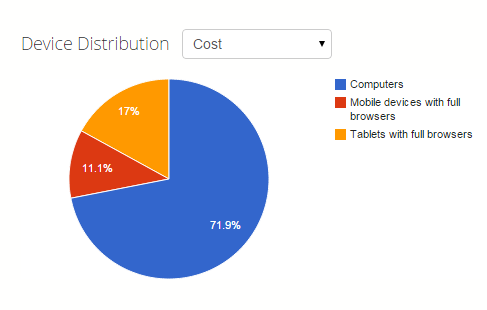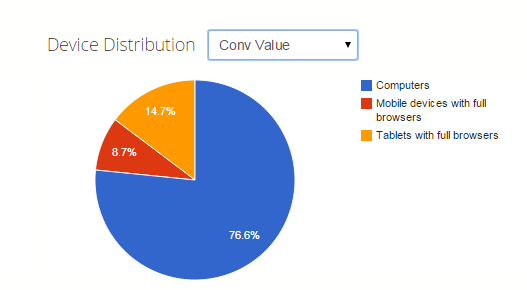(Warning: real-world data below!)
Most advertisers continue to be unimpressed by subjective criteria in online advertising. And complex attribution patterns can involve too many leaps of faith. And yet…
Is that a spring thaw you hear outside the window of your digital marketing event? No, that gushing sound you hear is the din of unanimity regarding the importance of the mobile channel.
That’s a far cry from years ago when advertisers simply raced to turn mobile off. Searches from phones tended to drain funds mercilessly; conversion rates were miniscule. Although device-switching still tends to hamper attribution efforts, today we have a reasonable expectation that a reasonable proportion of our smartphone and tablet users will convert via a normal checkout process. We’re not going to buy these clicks without some proof that somebody converts directly some of the time.
Conversions don’t grow on trees. Auctions are competitive. So campaign managers who fail to be vigilant in every segment are likely to waste clients’ money. That’s especially the case in accounts where – whether or not this is the optimal stance, strategically – the monthly budget is finite.
So what’s going on in the mobile channel? If it’s such a high-growth area in terms of user behavior, shouldn’t we be throwing major dollars at it? Such high level generalizations don’t do justice to the detailed optimization required.
Things are improving. We’re not saddled anymore with the busywork of setting up multiple campaigns for different devices. At one point, it was becoming almost common practice to set up campaigns to account for each of computers, tablets, and smartphones. Take a 50-category campaign, multiply it by 20 geographic segments also requiring their own campaign, and then multiply that 1,000-campaign mess by three… it was tough to find Occam’s Razor in that hellish haystack of data.
Whereas mobile was once either “stay away entirely,” or “meticulously manage it,” any sexy profession tends to attract drifters who are less obsessed than the previous generations. For every admirable control freak managing a PPC campaign, there are three blissed-out optimists who simply don’t like to rock the boat. Why turn stuff off (or down) when your friendly pundit who happens to work for a search engine seems so disappointed in you when you do? Really: it’s OK to be polite but firm when it comes to a salesperson’s agenda, even if they work for a cool tech company. “We’re buying a lot of media from you and will continue to do so. Now let us get back to managing it for maximum ROI. Thank you.” Etc.
By contrast with clueless newbies bent on wasting their companies’ advertising dollars, we’ve spent most of the past couple of years – in most, but not all industry sectors – bidding mobile channels down. We want the traffic. We just want to normalize ROI by channel and segment. Simple concept, really.
What you see below is the breakdown of click costs (over the past 90 days) by device type for one of our clients, a large e-commerce site. Tablets and mobile (smartphones) combined accounted for 28.1% of our spend.

In a perfect world, that would be higher, especially given the growing use of phones. If behaviors were comparable, we’d spend closer to half the budget in mobile. But we throttle back in that channel for two reasons: (1) the ROI appears lower, and although device switching may account for some of that and we’re willing to loosen our ROAS targets a little, we won’t grant the channel the benefit of too much doubt; (2) this client’s website is pretty hard to use on a phone – even so, it’s amazing how dogged some customers are in the pursuit of a purchase! Long bus rides, etc., must be good for business, but the need for a better mobile buying experience is hampering results for now.
These cost and revenue figures are the numbers after we adjust bids for smartphones. A typical bid adjustment here is somewhere between -25% and -55%. We’re happy with how the channel is working, because we can control it. Without those bid adjustments, the disparity in ROI would be ugly.
Here are our revenue figures. The mobile channels combined account for only 23.4% of attributed revenues. Not bad. Tablet revenue account-wide is 14.7% of revenue, as opposed to 17.0% of cost.

We can’t control the tablet bid, unfortunately. Poring through the data on many individual products, it’s clear (at least in this mainstream, high-intent, low-consideration context) that Google’s broad claim about tablet behavior is true: the tablet channel often performs more or less the same as computers. But the reality is, user experience and intent vary widely by sector, and by product. The data show clearly that there are certain products people like to ruminate on. I don’t discount the value of some high-funnel, consideration phase clicks. We just don’t want to overpay.
Despite the obvious utility of tablets, as PPC managers, we’d like the power to “sculpt out” the areas of lower performance and lower intent. We don’t want to encourage multiple clicks from people endlessly ruminating on a “cool” purchase. Some assist clicks here and there – great. It’s really just a matter of figuring out what is an appropriate total cost for a conversion, especially when we’re paying multiple times.
The tablet channel stands out as a sore point, but until Google offers us bid control over the channel (breaking: Bing Ads now offers up to a -20% bid adjustment to tablets), at least we can carry on with the overall “control freak” methodology intact, improving performance by tweaking campaigns along many dimensions; especially, using the “sculpting” method to surgically avoid dead spots in intent.
The average advertiser is, well… average in this regard. Imagine never trying to “sculpt out” the areas of weaker intent, never looking at match types, query reports, mobile bids, geo modifiers, setting up a long term methodology to test ad creative, etc. To the “average” advertiser, PPC must seem like a costly channel indeed.
If I want you to take away anything from this piece, it’s this: yes, the smartphone channel works just fine. But it’s working because we have the ability to bid it down significantly (in e-commerce, -40% is typical). And of course, there are some industries, especially local and phone-centric businesses, that prefer mobile clicks and will want to bid higher on them. Absolutely. It’s all about customization, context, and control.

